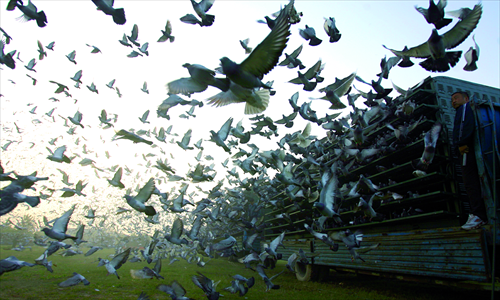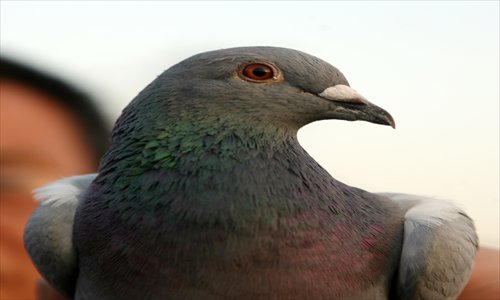Pigeon racing takes flight in China


The sport of pigeon racing might have first taken off in Western Europe with the Romans in 220AD, however it didn't find a perch in China until the 1960s in Shanghai. Back then, the main breeds of pigeons used for racing were the native Li and Yang species. China's reform and opening-up in the late 1970s saw an influx of foreign breeds introduced into the country however, causing the sport to soar.
Big domestic races
Boasting about 30,000 registered members, the Beijing Racing Pigeon Association (BRPA) is preparing to sound its air horn for this year's first homing pigeon race in Xinxiang, Henan Province, on April 22. The 550-kilometer race, which involved 20,000 pigeons last year, will this year see feathers fly among pigeons from Beijing's 14 districts and two counties.
The birds will be transported to the race course via trucks, then taken out from their lofts and released to fly home. With electronic timing, the first pigeon past the post stands to pocket its owner 3,000 yuan ($474.60) and a trophy. The BRPA will also have a flock of competitors in a 1,000-kilometer national race in Hubei Province, as well as another 600-kilometer race in Henan Province, both slated to be held in May.
The BRPA is currently spearheading intensive training for its members ahead of the big races. Pigeon trainers are already familiarizing their birds with the courses. "Usually, we put our pigeons through five or six days of intensive training ahead of a big race," said Wu Changfu, 56, who trains 50 pigeons and will enter 10 into the Henan race.
"It takes about six hours for the pigeons to fly 500 kilometers."
Endurance and speed
Bred with an innate homing ability, modern-day homing pigeons have been known to fly up to 1,800 kilometers in a single race at speeds of between 80 to 170 kilometers per hour.
Pigeons usually begin racing at six months old and compete until they are 10 years old. Ding Haichao, a 38-year-old pigeon owner who took up the sport 16 years ago, said some pigeons begin racing at just three months old.
Most racing pigeons are of foreign breeds as they are faster then domestic ones. In an average 500-kilometer race, foreign breeds can finish up to a half hour faster than their Chinese counterparts, said Wu.
It isn't all glory for pigeon owners though. Training their birds often spans an hour early in the morning and late in the afternoon. While the birds are away, the owner usually busies themselves by disinfecting their birds' aviary.
"It is important to train pigeons to fly when the weather is not so favorable, such as in rain or snow. This way, they can get good exercise and brace themselves for inclement weather during races," said Ding, who owns the Beijing Shouxin Homing Pigeon Loft in the capital's southern Daxing district and raises about 1,000 pigeons for different owners.
Flippin' the bird
Although pigeon racing originated in the West, it has flown to new heights in China half a century after it first made its mark. Prize money for pigeon races in China can reach as high as one million yuan, proving the sport is big business among enthusiasts.
In January last year, a Chinese buyer paid $200,000 for a racing pigeon at a Belgium auction, setting a new world record. The bird's name was Blue Prince, and he was one of the highly pedigreed racing pigeons that have long been considered the gold standard in the pigeon racing world.
While there are concerns among pigeon racing purists in Europe that the sport faces decline amid the continent's debt crisis and aging of bird owners, more young people in China are taking an interest in the sport, ensuring its future remains bright.
Passion for competition coupled with lucrative prize money offered in races suggests pigeon owners in China are in it for the long haul, and aren't merely winging it.